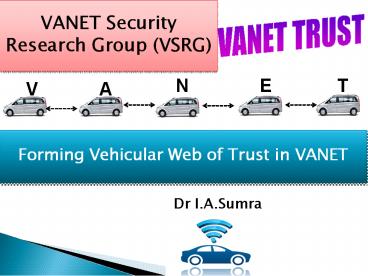Forming Vehicular Web of Trust in VANET - PowerPoint PPT Presentation
Title:
Forming Vehicular Web of Trust in VANET
Description:
The main idea behind trusted computing is the hardware based TPM which contains active security modules that supports web of trust to be built within components of the network. We propose a new model for web of trust within vehicular to handle all types of attacks and maintain the integrity of messages. – PowerPoint PPT presentation
Number of Views:73
Title: Forming Vehicular Web of Trust in VANET
1
VANET Security Research Group (VSRG)
VANET TRUST
Forming Vehicular Web of Trust in VANET
- Dr I.A.Sumra
2
Overview
- Introduction
- Requirement of Trust in P2P Vehicular network
- Properties and components of Trust in Vehicular
Network - Proposed Trust Levels
- Types of TRUST in Vehicular Network
- Conclusion
- References
- QA
2
3
- Vehicular ad-hoc network is a special kind of
network in which nodes (Vehicles) can communicate
with each other on the road and with its
Infrastructure.
V2I
3
4
VANET Applications
- Safety Applications
- Non Safety Applications
Work Zone Warning!!!
Work Zone Warning!!!
Work in Progress Plz! use Alt. route
Shopping MALL ( TESCO )
Parking Slot Available!!!
Parking Slot Available!!!
RSU
4
5
Trust
- an entity can be trusted if it always behaves in
the expected manner for intended purpose. - all components of the network (vehicles and
infrastructure) are behaving in an - expected manner
- (secure communication between the components) and
serve the users and save human lives.
6
Component Behavior
- User Behavior
- Node Behavior
- Road Side Unit (RSU) Behavior
7
Security and Trust
- Security is one of the most important issues in
vehicular network. Applications of vehicular
network should be secure and user receives right
information while traversing along their journey.
- Trust is also a key component of security and
trust is governs the behavior all components in
the network which must behave in the expected
manner. - User, vehicle and road side unit (RSU) are some
components of trusted vehicular network. If any
of these components of network unexpectedly
change their behavior then it would signify that
there is a breach of trust in the network.
8
Requirement of Trust in P2P Vehicular network
- What is TRUST A system or component that
behaves in expected manner for the particular
purpose . - TRUST in VANET All components of the network
(user, vehicles and infrastructure) are behaving
in an expected manner (trusted communication
between the components) and serve users which
subsequently would save human lives.
9
Properties and components of Trust in Vehicular
Network
- Context Dependence
- Function of Uncertainty
- Quantitative Values
- Transitivity
- Asymmetry
- Personalization
Components of TRUST in Vehicular Network
10
PROPOSED WEB OF TRUST MODEL
- In the proposed Vehicular Web of TRUST (VWT)
environment the each vehicle possess a Trust
Module with a TPM hardware module inside the
vehicle.
11
Levels of TRUST
- 1. Trust between TPMs and Vehicle Sensors
- 2. Trusted Medium (DSRC)
- 3. Trust between Vehicle to Vehicle (V2V)
- 4. Trust between Vehicle to Infrastructure (V2I)
12
Levels of TRUST
- Trust between TPMs and Vehicle Sensors
13
Levels of TRUST
- 2. Trusted Medium (DSRC)
- At the second level, the role of the medium is
important, dedicated short range communication
(DSRC) frequency band is used for all types of
communication in VANET. - DSRC provides multiple channels and its
transmission ranges from 5.850 to 5.925 GHz. DSRC
are divided into seven channels and each channel
range is 10 MHz. - Every vehicle in the network receives messages
from other vehicles or from infrastructure. A
secure and trusted content of message is the
major concern of the users.
14
Levels of TRUST
- 3. Trust between Vehicle to Vehicle (V2V)
15
Levels of TRUST
- 4. Trust between Vehicle to Infrastructure (V2I)
16
Direct Anonymous Attestation (DAA)
- DAA is a digital group signature scheme and it
was originated by Brickell, Camenisch and Chen. - It provides the facility to a third party to
validate the TPM, and check whether the user
platform is genuine. - In VANET environment, DAA can be considered for
attesting a vehicle platform, and at the same
time protecting the privacy of the user. Using of
DAA we can develop the four level of trust in
vehicular communication.
17
Conclusion
- Reducing the death rate, avoiding congestion on
roads and makes comfortable journey some of key
objective of vehicular network. - Security and trust are becoming increasingly key
challenges issues in vehicular network. - TPM hardware module is the key module of trusted
computing and that supports to develop trust in
vehicular communication environment. - In this paper we have presented new model for web
of trust within vehicular network and this model
are based on four level of trust.
18
- Please download complete paper from
- IEEEE website
- ResearchGate
18
19
19

